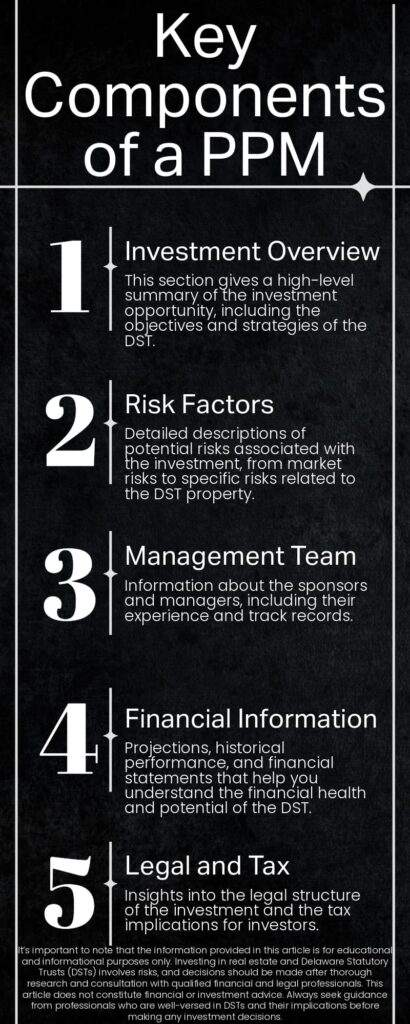In this article we will be discussing the benefits of a DST. This is meant...
Read MoreIntroduction
Investing in real estate is a significant decision, especially when it involves a Delaware Statutory Trust (DST). As enticing as the benefits may sound—potential tax advantages, passive income, and diversification—there’s a crucial document you need to understand before diving in: the Private Placement Memorandum (PPM). The very mention of it can send shivers down an investor’s spine. Is it as intimidating as it sounds? How can you be sure you’re making a sound decision? This guide will demystify the PPM, giving you the confidence to invest wisely in DSTs.
What is a Private Placement Memorandum?
A Private Placement Memorandum (PPM) is a legal document provided to potential investors when selling securities in a private placement. Unlike public offerings, private placements do not require registration with the SEC, making the PPM essential in conveying all the necessary information about the investment.

Why Understanding the PPM is Crucial:
Protecting Your Investment
The primary purpose of a PPM is to protect both the issuer and the investor. For the issuer, it ensures compliance with securities laws and provides a clear record of what was disclosed. For the investor, it offers a detailed overview of what you’re getting into, helping you make an informed decision.
Identifying Red Flags
Reading a PPM carefully can help you spot potential red flags. These might include overly optimistic financial projections, lack of detailed risk factors, or a management team with a poor track record. Identifying these early on can save you from making a costly mistake.
Delving Into the Details: Sections of the PPM:
Investment Overview
This section of the PPM sets the stage for the entire investment. It outlines the goals, strategies, and structure of the DST. You’ll learn about the property or properties involved, the expected holding period, and the anticipated exit strategy. Pay close attention to how the investment aligns with your financial goals and risk tolerance.
Risk Factors
Risk factors are perhaps the most critical section of the PPM. This is where the potential downsides are laid out. From market fluctuations to specific issues related to the property or management team, this section provides a reality check. Understanding these risks helps you gauge whether the potential rewards are worth it.
Management Team
The success of a DST often hinges on the expertise and reliability of its management team. This section of the PPM provides detailed biographies of the key players, their experience in managing similar investments, and their track records. A seasoned, transparent management team can significantly reduce the risks associated with the investment.
Projections and Historical Performance
Financial projections give you an idea of what to expect in terms of returns, but it’s essential to view them with a critical eye. Compare these projections with the historical performance of similar investments by the same management team. Look for consistency and realism in these numbers.
Financial Statements
Detailed financial statements provide a snapshot of the DST’s current financial health. These should include balance sheets, income statements, and cash flow statements. Understanding these documents can help you assess the viability of the investment and its potential to meet the projected returns.
Legal Structure
The legal section of the PPM explains the structure of the DST and your rights as an investor. This includes information on ownership, transferability, and what happens in various scenarios (e.g., if the DST is sold or if you want to exit early).
Tax Implications
Investing in a DST can have significant tax advantages, but it’s crucial to understand the specifics. This section will outline how the income and potential gains are taxed and any benefits you might receive, such as deferral of capital gains taxes through a 1031 exchange. Consulting with a tax advisor to understand these implications in your context is advisable.
How to Read a PPM Effectively:
Take Your Time
A PPM is a dense document, often running hundreds of pages. Don’t rush through it. Allocate ample time to read and understand each section thoroughly.
Seek Professional Advice
Even if you’re an experienced investor, consulting with professionals such as financial advisors, tax experts, and attorneys can provide valuable insights and ensure you’re not overlooking critical details.
Ask Questions
If anything is unclear, don’t hesitate to ask the issuer for clarification. A reputable issuer will be transparent and willing to provide additional information.
The Role of the PPM in DST Investments:
Ensuring Transparency
The PPM is the cornerstone of transparency in DST investments. It lays out all the cards on the table, ensuring that you have all the information needed to make an informed decision. This transparency builds trust between the issuer and the investor, a crucial element in any investment.
Legal Protection
A well-crafted PPM provides legal protection for both parties. For investors, it’s a documented record of what was disclosed, which can be critical if disputes arise later. For issuers, it’s a means to comply with legal requirements and protect against potential lawsuits.
Wrapping Up:
Understanding a Private Placement Memorandum (PPM) is not just a recommended step but a necessary one for anyone considering investing in a DST. It provides a comprehensive overview of the investment, outlines the risks, introduces the management team, and details the financial and legal aspects. By thoroughly reviewing the PPM, you can make an informed decision that aligns with your financial goals and risk tolerance.
It’s important to note that the information provided in this article is for educational and informational purposes only. Investing in real estate and Delaware Statutory Trusts (DSTs) involves risks, and decisions should be made after thorough research and consultation with qualified financial and legal professionals. This article does not constitute financial or investment advice. Always seek guidance from professionals who are well-versed in DSTs and their implications before making any investment decisions.





